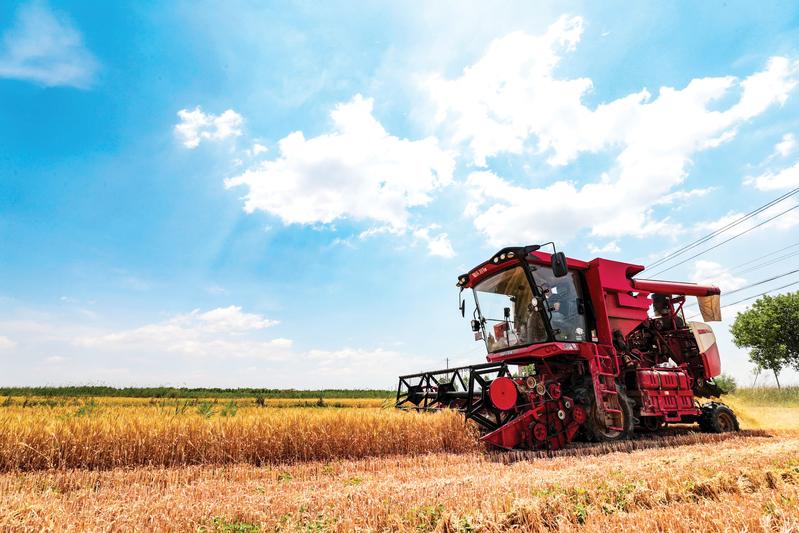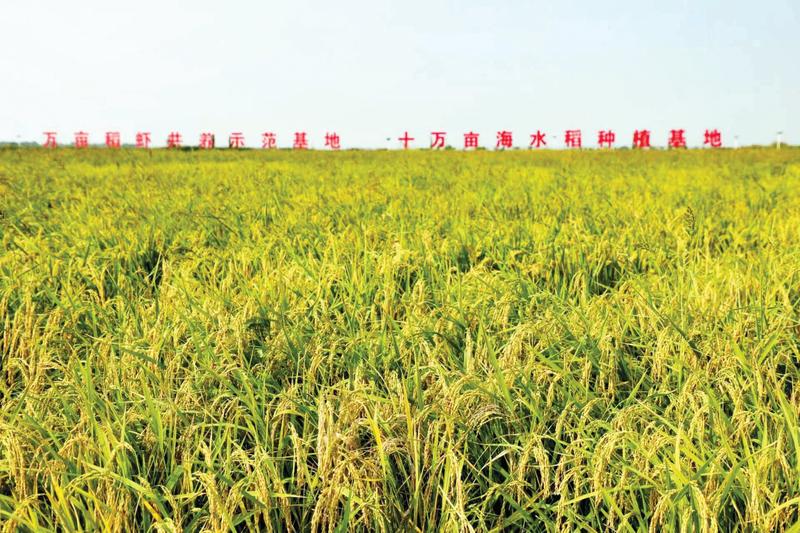Salt-tolerant varieties of rice, other crops help supplement China’s agricultural land and production
 (SONG CHEN / CHINA DAILY)
(SONG CHEN / CHINA DAILY)
Alarge expanse of fragrant seawater rice plants wafted in the wind in autumn sunshine at the Yuwang Wetland in Weifang, a coastal city in Shandong province.
Such rice is salt-tolerant, but is not grown in the sea. Several years ago, the area around the wetland was dubbed “white land” by locals, as the high salt content left a distinctive “frost” on the top layer of soil.
Tian Guoqing, general manager of Shandong Binyuan Agricultural Science and Technology Co, which runs the seawater rice area in the city’s Hanting district, said: “The 3,866-plus hectares of crops are expected to produce more rice this year than last year.”
After three years of work to manage the salt-affected soil and cultivate salt-tolerant seeds, the once-barren land has been transformed into a productive area for seawater rice, demonstrating efficient use of salt-affected soil.
Carlos Watson, representative of the UN Food and Agriculture Organization, or FAO, in China, said at an international conference held in Weifang in September on salt-affected soil that “soil salinization is a significant problem worldwide”.
According to State of the World’s Land and Water Resources for Food and Agriculture report, published by the FAO last year, more than 1,100 million hectares of soil are affected by salinity and sodicity (which degrades soil properties), Watson said. Of this total, 60 percent of the soil is saline, 26 percent sodic, and the remaining 14 percent saline-sodic.
China has 100 million hectares of salt-affected soil, about the size of Egypt, and one-third of this soil has the potential for agricultural activities, according to the Ministry of Agriculture and Rural Affairs.
Agricultural workers are committed to comprehensively using salt-affected soil — employing methods ranging from managing the soil to make it suitable for crops, to breeding salt-tolerant crop varieties.
Xu Xing, professor of agricultural science at Ningxia University in Ningxia Hui autonomous region, said, “We have cultivated salt-tolerant goji (Chinese wolfberries), corn, rice and grapes on the Hetao Plain along the upper Yellow River, adding color to this once-white land.”
In Shandong, more than 386,600 hectares of salt-affected soil has been treated to grow crops and fruit.
Dongying, where the Yellow River flows into Bohai Bay in Shandong, boasts a large area of soil with high levels of salinity as a result of coastal erosion and high levels of saltwater saturation.
 A harvester gathers wheat from salt-affected land in Lijin county, Dongying, Shandong province, in June. (PHOTO PROVIDED TO CHINA DAILY)
A harvester gathers wheat from salt-affected land in Lijin county, Dongying, Shandong province, in June. (PHOTO PROVIDED TO CHINA DAILY)
Wang Guangmei, head of the Yellow River Delta field ecosystem scientific observation and research station responsible to the Chinese Academy of Sciences’ Yantai Institute of Coastal Zone Research, noticed cracks on the salt-affected land when he visited the delta four years ago.
“There were salt stains everywhere, and plants were rarely seen,” Wang said.
To develop the salt-affected soil, the State Council (China’s Cabinet) approved the establishment of the Agricultural High-tech Industrial Demonstration Area of the Yellow River Delta in Dongying in 2015. It aims to turn the area into a new comprehensive model for the use of saline land, and contribute to the modernization of agriculture.
The demonstration area covers 350 square kilometers, of which more than 80 percent is salt-affected land, according to the local government.
To improve the soil structure, Wang and his colleagues planted grasses to be used as forage.
“By planting the forage grasses, we can cover more areas with them — reducing the accumulation of salt on the surface soil. When these grasses are ripe, we plough them into the soil to enrich its composition by creating more nutrients and increasing its organic matter,” Wang said.
Wang’s team has also customized microbial fertilizers for the soil.
After four years’ work, the organic matter in soil in the demonstration area rose by more than 8 percent on average, while its salt content fell by 21 percent, according to statistics from the observation and research station.
 Seawater rice plants stand in a field in Weifang, a coastal city in Shandong. (PHOTO PROVIDED TO CHINA DAILY)
Seawater rice plants stand in a field in Weifang, a coastal city in Shandong. (PHOTO PROVIDED TO CHINA DAILY)
While improving the soil quality, experts are also cultivating salt-tolerant plant varieties. Using modern cultivation techniques, 37 new varieties of salt-resistant plants, including quinoa, alfalfa, oats and triticale, have been grown in the area.
In Dongying’s Hekou district, varying levels of salinity affected 89 percent of the 34,260 hectares of arable land, and agricultural workers have cultivated more than 20 varieties of salt-tolerant crops on such soil in the district.
Chen Xinguo, who oversees the Yellow River Delta Salt-tolerant Soybean Industrial Innovation Center, said, “We plan to cultivate three new varieties of salt-tolerant soybean crops by 2025.”
Located about 20 kilometers from the Bohai Sea coastline, the Yuwang Wetland in the northern part of Hanting district was once a large, barren area with more than 12,000 hectares of salty soil in which crops could not survive.
Since 2019, Shandong Binyuan Agricultural Science and Technology Co has worked with a team formed by the late Yuan Longping, the nation’s top agricultural scientist who was known as the “father of hybrid rice”, to improve the salt-affected soil and cultivate salt-tolerant rice varieties.
The company planted 1,673 hectares of rice on salt-affected soil at the wetland in 2020, with the average production of rice per mu (0.07 hectares) reaching 691 kilograms, double the yield in 2019.
Tian, the general manager, said, “Salt-tolerant rice seeds developed by agricultural experts are key to ensuring a bountiful harvest.”
The experts planted more than 30 varieties of rice on different areas of the saline-alkali soil, finally selecting six. In addition, they developed two local varieties.
“The newly developed localized varieties of rice are more salt-tolerant, more resistant to disease, and they have thicker stalks to withstand the wind in areas close to the coast,” Tian said.
 Wheat growers inspect produce on salt-affected land in Kenli district, Dongying, in June. (BO HUARUI / FOR CHINA DAILY)
Wheat growers inspect produce on salt-affected land in Kenli district, Dongying, in June. (BO HUARUI / FOR CHINA DAILY)
The company planted 330 hectares of crops using the two localized seed varieties for a trial last year, with the average yield per mu surpassing 600 kg, Tian added.
To better make use of the salt-affected soil, Tian said two pipes were laid underground for irrigation and to leach out salt.
Aided by data from smart sensors and cameras, the artificial intelligence agricultural system provides the correct quantity of water for the soil.
Compared with farmers traditionally irrigating their fields by using large amounts of fresh water, the new methods can save up to 30 percent of water.
Tian believes that planting seawater rice is a promising business.
“We can make the best use of salt-affected soil by making the best use of seawater rice. Due to the special growing environment, the level of selenium in seawater rice planted in saline-alkali soil is seven times higher than in ordinary rice, making seawater rice healthier,” he said.
Selenium is a trace element that works as an antioxidant in the body by preventing damage to the cells that some particles from the environment can cause.
Produce made from seawater rice grown at the Yuwang Wetland is displayed at an exhibition hall in the area.
Shao Honggang, chairman of Weifang Bincheng Investment and Development Co, said, “We have developed more than 60 types of produce from seawater rice, such as white liquor, or baijiu, rice noodles and condiments, which have earned a good market reputation.”
He added that his company sold 50,000 cases of zongzi, a type of sticky rice, during the Dragon Boat Festival this year, which is a good market performance.
The company is now developing face masks made from extracts of seawater rice husks, and bread and hamburgers made from seawater rice flour, along with a tourism project in the wetland area.
“We are building the project to educate visitors about the comprehensive development of saline-alkaline soil,” Shao said.
“Forming a complete industrial chain to make seawater rice and the produce made from it widely known will enable the comprehensive use of salt-affected soil to continue.”


